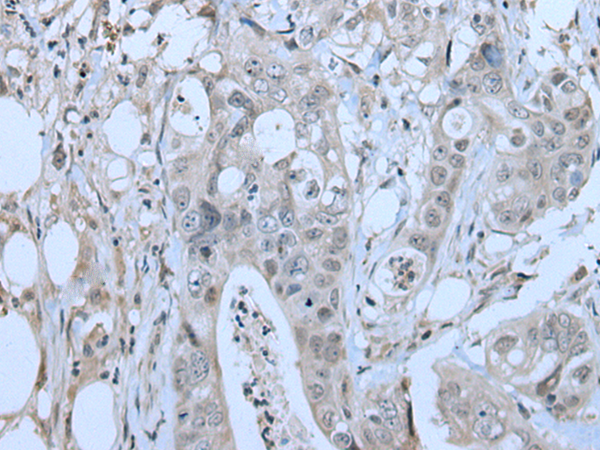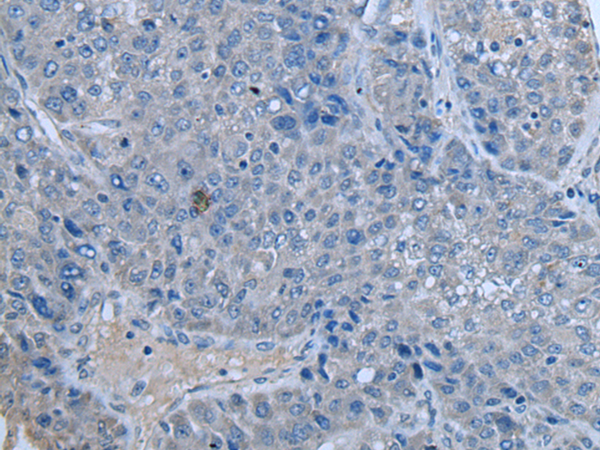

| WB | 咨询技术 | Human,Mouse,Rat |
| IF | 咨询技术 | Human,Mouse,Rat |
| IHC | 1/20-1/100 | Human,Mouse,Rat |
| ICC | 技术咨询 | Human,Mouse,Rat |
| FCM | 咨询技术 | Human,Mouse,Rat |
| Elisa | 1/5000-1/10000 | Human,Mouse,Rat |
| Aliases | ZNF923 |
| Host/Isotype | Rabbit IgG |
| Antibody Type | Primary antibody |
| Storage | Store at 4°C short term. Aliquot and store at -20°C long term. Avoid freeze/thaw cycles. |
| Species Reactivity | Human |
| Immunogen | Synthetic peptide of human ZBTB40 |
| Formulation | Purified antibody in PBS with 0.05% sodium azide and 50% glycerol. |
+ +
以下是关于ZBTB40抗体的3篇参考文献,包含文献名称、作者及简要摘要内容:
---
1. **文献名称**:*ZBTB40 regulates osteoblast function and bone mass through transcriptional regulation of SOST*
**作者**:Zhang Y, et al.
**摘要**:该研究通过免疫沉淀(ChIP-seq)和Western blot技术,利用ZBTB40抗体探究其在成骨细胞中的调控机制。发现ZBTB40通过抑制SOST基因(编码硬化蛋白)表达,促进骨形成,为骨质疏松症的治疗提供潜在靶点。
2. **文献名称**:*ZBTB40 modulates macrophage polarization and inflammatory responses via NF-κB signaling*
**作者**:Chen L, et al.
**摘要**:研究使用ZBTB40抗体进行免疫组化及流式细胞术,发现ZBTB40通过调控NF-κB通路影响巨噬细胞的M1/M2极化,在炎症性疾病中起关键作用,为免疫调节机制提供新见解。
3. **文献名称**:*ZBTB40 suppresses hepatocellular carcinoma metastasis by targeting epithelial-mesenchymal transition*
**作者**:Wang X, et al.
**摘要**:该研究利用ZBTB40抗体进行免疫荧光和Western blot分析,揭示ZBTB40通过抑制上皮-间质转化(EMT)相关基因表达,降低肝癌细胞的侵袭和转移能力,提示其作为肝癌预后标志物的潜力。
---
以上文献均涉及ZBTB40抗体的实验应用(如Western blot、ChIP-seq等),并探讨了ZBTB40在骨骼、免疫及癌症中的功能机制。如需具体发表年份或期刊,可进一步补充数据库检索。
The ZBTB40 antibody is a crucial tool for studying the ZBTB40 protein, a member of the zinc finger and BTB (Broad-Complex, Tramtrack, and Bric-à-brac) domain-containing protein family. ZBTB40. also known as Zinc Finger Protein 852. functions as a transcription factor involved in regulating gene expression, particularly in immune cells, neurons, and certain cancer types. It contains C2H2-type zinc finger motifs and a BTB domain, enabling DNA binding and protein-protein interactions, respectively. Research highlights its role in modulating immune responses, neurodevelopment, and cellular differentiation, with emerging links to diseases such as autoimmune disorders and malignancies.
The ZBTB40 antibody is widely used in techniques like Western blotting, immunohistochemistry, and chromatin immunoprecipitation (ChIP) to detect protein expression, localization, and DNA-binding activity. Its specificity is often validated via knockout controls or siRNA-mediated protein depletion. Commercial antibodies are typically raised in rabbits or mice, with monoclonal and polyclonal variants available. Studies employing this antibody have shed light on ZBTB40’s interaction with chromatin modifiers (e.g., HDACs) and its regulatory effects on genes linked to inflammation, apoptosis, and cell cycle progression.
Recent investigations also explore ZBTB40’s epigenetic roles, particularly in histone modification and transcriptional repression, underscoring its potential as a therapeutic target. However, challenges remain in standardizing antibody performance across experimental models, necessitating rigorous validation for reproducibility. Overall, the ZBTB40 antibody is pivotal for unraveling the protein’s biological significance and its implications in health and disease.
×